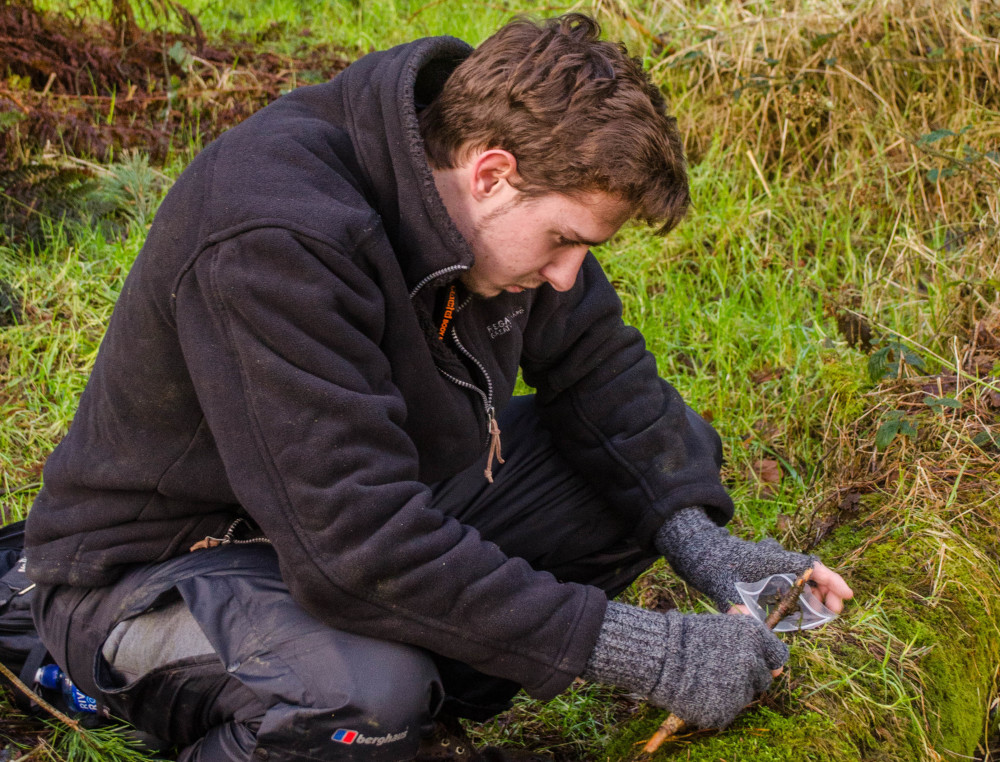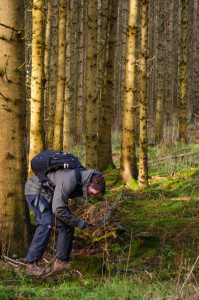Pine martens and red squirrels

Investigating a possible link between pine martens and red squirrel populations.
The project
Josh Twining is looking at whether the pine marten has a role to play in the conservation of red squirrels. The return of pine marten in areas on Ireland coincided with a recent decline in grey squirrels, allowing red squirrels to return to areas where they had not been present for 30 years. Josh’s project will help clarify whether grey squirrels are being preyed upon on in areas where they are coming into contact with pine marten.
Josh says: “I moved to Belfast and started my internship in early November. My internship is looking at the role of the Pine Marten (Martes martes), if any, in the conservation of the native red squirrel (Sciurus vulgaris) in Britain. Recently there has been suggestions that the return of the pine marten and its increasing distribution may be linked to anecdotal reports of increasing red squirrel numbers. It may be that martens create a “climate of fear” in invasive grey squirrels (Sciurus carolinensis), in which fear of the pine martens suppresses reproduction and foraging in grey populations. Or it has been suggested that the larger weight and terrestrial nature of greys make them easier to catch and therefore they are an easily accessible prey source for martens. It is my role with the support of PTES to investigate this question and provide quantitative data on the subject. To do this I am investigating the diet of the pine martens, as increased predation could be one possible direct pressure that would cause this observed change.
 “To do this I selected 24 sites from previous camera trapping work in forestry sites all over Northern Ireland which have relatively high abundances of martens and the presence of either red or grey squirrels. I visit each of these sites monthly and walk 3km line transects looking for marten scat. This is the glamorous work of most mammologists who study elusive and rare mammals, a highlight is getting to visit some of Northern Ireland’s most beautiful forest reserves. I repeat every site monthly as I am looking for seasonal variation in the diet of martens which may have been missed in previous studies. As marten scat can be easily confused with fox scat even by experts, I photograph and record location and morphological features of every scat and then a tiny amount of each scat is sent off for genetic testing to identify source species.
“To do this I selected 24 sites from previous camera trapping work in forestry sites all over Northern Ireland which have relatively high abundances of martens and the presence of either red or grey squirrels. I visit each of these sites monthly and walk 3km line transects looking for marten scat. This is the glamorous work of most mammologists who study elusive and rare mammals, a highlight is getting to visit some of Northern Ireland’s most beautiful forest reserves. I repeat every site monthly as I am looking for seasonal variation in the diet of martens which may have been missed in previous studies. As marten scat can be easily confused with fox scat even by experts, I photograph and record location and morphological features of every scat and then a tiny amount of each scat is sent off for genetic testing to identify source species.
“Scat is then transported to the lab where I autoclave it (dry it out) and then perform traditional macro analysis. Macro analysis being separating and identifying contents of the scat, be that bone fragments, hair, feathers, stones from berries or exoskeletal remains and use keys to identify species present. Once I have identified all species present I am able to use various indices to infer how much of martens scat is made up of red or grey squirrels proportionally. I also use some nifty correctional values from previous research to estimate the biomass of each food species consumed by the martens. The project is still in the preliminary phases and I am unable to make any conclusions as of yet.”
Latest update
Josh says: “I’ve now been collecting pine marten scats for eight months and have amassed an impressive 600 from 23 sites throughout Northern Ireland. Our early results show that pine martens appear to have a broad dietary niche which changes quite dramatically throughout the year.
Small mammals, birds, invertebrates and fruit and nuts are the most common food groups, with small  mammals occurring most frequently. It seems that their favourite prey – or at least the most abundant in their scats – are pygmy shrews, followed by wood mice. They also rely heavily on birds – predominantly passerines but they will opportunistically take many other species too. 30% of scats have also contained beetle remains, and 10% contained human refuse. It might be that they rely on food from bins in the harder months.
mammals occurring most frequently. It seems that their favourite prey – or at least the most abundant in their scats – are pygmy shrews, followed by wood mice. They also rely heavily on birds – predominantly passerines but they will opportunistically take many other species too. 30% of scats have also contained beetle remains, and 10% contained human refuse. It might be that they rely on food from bins in the harder months.
Recently, with the fruiting of various plants in July and August, martens appear to have been exploiting the ephemeral, energy rich food sources of bilberry, rowan and blackberry – which have alternating been dyeing their scats deep purple and vibrant red, making them very easy to spot! As of yet no evidence of grey squirrels has been found, although traces of red squirrels have.”
